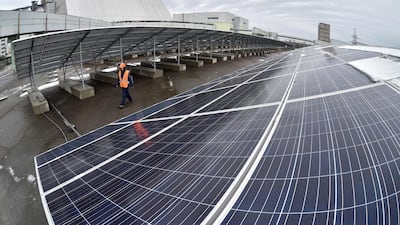Gulf Arab states are spending billions of dollars on developing renewable energy projects, but the advantages of these investments may be limited unless greater reforms of domestic power markets are embraced with equal enthusiasm for the benefit of all consumers.
In Europe, where the share of electricity produced from renewables is expected to account for a third of total energy demand by 2030, the traditional model of large generating utilities is breaking down.
The benefits for households and industrial consumers in the long-term will be cheaper energy and more flexibility to change providers as they would a mobile phone contract.
Meanwhile, mainly state-controlled producers of electricity still tightly control the reins of supply and distribution in the Middle East despite the liberalisation of some markets over two decades ago. Power remains relatively expensive for retail consumers in a region, which controls about 60 per cent of the world’s hydrocarbon reserves.
Of course, the necessity to produce desalinated water with expensive combined-cycle gas-fired power plants makes structural market reform infinitely more complicated. But there are compelling reasons to free up investment in renewables across the region.
“It’s happening much faster than anyone ever imagined,” said Paddy Padmanathan, chief executive and president of developer Acwa Power in an interview with S&P Global Platts. “Renewable energy costs are coming down at a phenomenal rate. My view is that electrification will also be much faster than predicted. That includes electric mobility and, as we’re seeing, the decarbonisation of supply to industry,” he said.
Acwa has made some significant inroads into the market. On July 2, the company opened a 120 MW wind farm in Tangier, Morocco, with the power signed up by cement factories. Then Saudi Arabia’s Public Investment Fund increased its holding in Acwa to almost 25 per cent, helping to boost investment in renewables and gas-fired generation.
________
Read more:
Saudi leads renewable energy developments with $7bn in new tenders
China's Silk Road Fund is investing in Dubai solar project, Acwa says
Middle East renewables sector to register 24% CAGR by 2025, says GE
________
The trend to corporate power purchase agreements and own-generation of solar is allowing a raft of first-mover companies to lock in electricity prices and gain sustainability credentials, said Padmanathan. To date, it has been the region’s governments locking in price via long term take-or-pay agreements, signing up projects for 25 years or so.
“The tariff I sign up to today needs to endure for 25 years. Don’t confuse legal contracts with a willingness to pay if, in 10 years’ time, that contract is three times the prevailing energy cost,” said Padmanathan.
However, the biggest driver for renewable investment in the region is the potential for the long distance cross-border export of power to Europe and beyond. That was the grand vision of Saudi Arabia’s former oil minister Ali Al-Naimi, who foresaw the kingdom must look beyond petroleum for its future. Advances in technology could soon make his dream a reality.
Long distance power transmission projects are already happening around the world. A 1,300-kilometre-long high-voltage direct current (HVDC) transmission line is in operation in Brazil, while a 730-km subsea HVDC cable is being built between Norway and the UK. Both are designed to carry bulk power over long distances with minimal losses to load centres that otherwise would have to turn to more expensive options.
With the region’s developers driving significant cost reductions in conventional and now solar and wind projects compared to European counterparts, the prospect of an electricity exporting Middle Eastern power house may not be so far-fetched.
The potential is staggering. The Middle East with abundant sunshine and wind could potentially generate 888 gigawatts of power, equivalent to the global total as at end-2017. In Saudi Arabia, Acwa expects more than 50 gigawatts of renewable capacity additions in the next 15 years, and up to 30 gigawatts of gas-fired generation capacity installed. Much of the power will be required to meet domestic growth. In the kingdom, power consumption is expected to triple by 2030 when Riyadh has set a target of 9.5 gigawatts of renewable electricity.
And the more renewable power Saudi can generate the more crude it can free for export. The kingdom currently burns an estimated 700,000 b/d in its power plants to produce electricity.
For domestic consumers, however, this misses the point. Building solar is now cheaper than extracting oil for domestic power generation. Add storage to solar and you have green power around the clock. Reducing the region’s carbon footprint is the other major benefit.
In the UAE, the government has laid out its own plan known as Energy Strategy 2050, which aims to deliver 40 percent of domestic power generated from clean energy to reduce emissions. However, the test will be if these schemes can reduce the final cost of power to end users.
The switch to renewables is going to put money in consumer pockets - but it needs fuel price deregulation and increased private sector involvement to truly thrive in the Middle East where market reforms are needed the most to keep pace with new technology.
Henry Edwardes-Evans is head of power news, EMEA at S&P Global Platts

